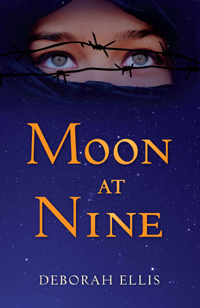| ________________
CM . . .
. Volume XX Number 26. . . .March 7, 2014 
 |
Moon at Nine.
Deborah Ellis.
Toronto, ON: Pajama Press, 2014.
223 pp., trade pbk. & hc., $16.95 (pbk.), $19.95 (hc.).
ISBN 978-1-927485-59-0 (pbk.), ISBN 978-1-927485-57-6 (hc.).
Subject Headings:
Lesbians-Juvenile fiction.
Iran-History, 1997-Juvenile fiction.
Grades 7-11 / Ages 12-17.
Review by Karen Boyd.
**** /4
Reviewed from Advance Reading Copy.
|
| |
|

excerpt:
Farrin opened her eyes. The student musician raised her head.
Farrin felt something like a jolt of electricity through her body as the most intense green eyes looked right into hers.
For a moment, Farrin forgot how to breathe. “Yes, I need... no, I mean... you can’t play that.”
“I’m not very good yet,” the musician said.
“No, no, you’re great, but you can’t ...I mean, it’s forbidden. You’ll get into trouble.”
“If it’s really forbidden, the school wouldn’t have a santour,” the girl said. “I think the rule against music is more of a suggestion than a rule. That’s what I choose to think, anyway.”
Fifteen-year-old Farrin is living in Tehran 10 years after the overthrowing of the Shah. In this new Iran, Farrin’s wealthy family struggles to maintain power and control in an environment with a highly conservative and religious government. Everyone is under tight surveillance, including the students at Farrin’s school for gifted girls. Farrin is used to being an isolated outsider, but when she meets the new girl Sadira, she begins to believe that friendship is possible. When their friendship becomes romantic, Farrin and Sadira risk everything to be together in a country where homosexuality is illegal and punishable by death.
Basing her book on a true story, Ellis has written a heartbreaking tale of prejudice and injustice. Ellis contrasts the sanctioned horrible treatment of human beings with an illegal love story. Farrin’s life is filled with terrible secrets that she has learned to keep. Her mother entertains at pro-Shah tea parties and cocktail parties. Her father profits from the slave labour of Afghan workers. The family servant, Ahmad, steals from the family to feed Afghan workers. The characters in Moon at Nine are often terrible to each other. Farrin’s mother refers to her as looking “like a bit of a monkey, with that dark skin of hers.” The school monitor takes great pleasure in ruling with fear and is supported and encouraged by the equally terrifying school principal. Farrin also witnesses the destruction of young life as the boys of Iran begin to come home, broken and destroyed, from the war with Iraq. Farrin, herself, manipulates and exerts power over the family servant to get her own way. In the midst all of these terrible events, Farrin finds love, beauty, acceptance, and happiness with Sadira. This contrast is shown to be all the more dramatic when it becomes obvious that it is this love that will be punished the most severely.
Set in 1988, Moon at Nine’s historical context of Iran at this time is subtly described. Readers can piece together the political and religious landscape through Ellis’ descriptions, but they are definitely the background and not the foreground of this story. Farrin and Sandira’s emotions and experiences are central to Moon at Nine. As typical teenagers, Farrin and Sadira believe that their love can conquer all. Their adolescence arrogance makes them take risks to be together. Farrin and Sadira believe that, if they just tell the truth and love each other, justice will prevail. As the story progresses, it is very clear that no decisions will be left up to the girls, and readers are swept up in the helplessness and powerlessness of women, and, more specifically lesbian women in 1988 Iran. While both girls’ stories end tragically, Ellis also illustrates the power of Farrin’s family money over the poverty of Sadira.
The characters are complex and carefully drawn by Ellis. As the story develops, readers are led to see beyond the surface presentation of the characters. Initially, Farrin’s mother seems to be an anti revolutionary activist, but it turns out that she is just a frivolous housewife who gets slightly tipsy over a tea-stained photograph of the Shah’s exiled son. Principal Kobra is a strict and stern taskmaster at the school, and the girls find it easy to believe the rumour that she is the interrogator at the prison. When Farrin actually finds herself in prison, it is Principal Kobra who visits and shows her kindness when her parents are nowhere to be seen. As a firm believer in the revolution, Principal Kobra says, “I was there at the beginning of it and I will defend it all my life. But in my revolution, we do not execute children.”
While we recognize some progress in our country in terms of gay and lesbian rights, Moon at Nine is a sobering reminder that being gay or lesbian is still a criminal offence in many countries in the world, and for many, the penalty is death. Ellis has given us this reminder with yet another beautifully written story, the love story of Farrin and Sandira.
Highly Recommended.
Karen Boyd is an instructor in the Bachelor of Education program at the University of Manitoba.

To comment
on this title or this review, send mail to cm@umanitoba.ca.
Copyright © the Manitoba Library Association. Reproduction for personal
use is permitted only if this copyright notice is maintained. Any
other reproduction is prohibited without permission.
NEXT REVIEW |
TABLE OF CONTENTS FOR THIS ISSUE
- March 7, 2014.
AUTHORS |
TITLES |
MEDIA REVIEWS |
PROFILES |
BACK ISSUES |
SEARCH |
CMARCHIVE |
HOME |
